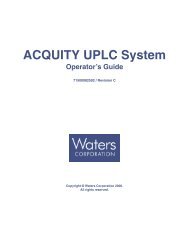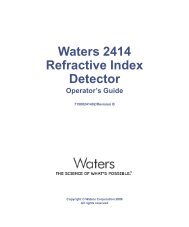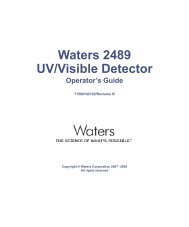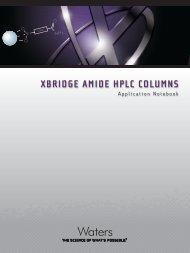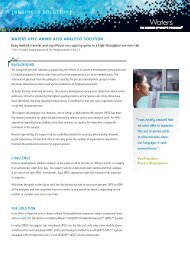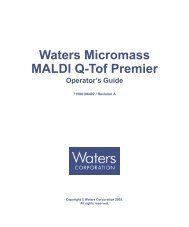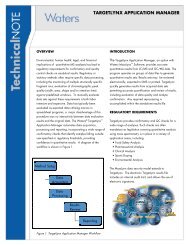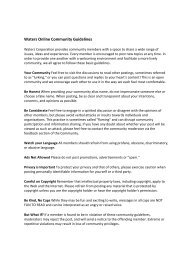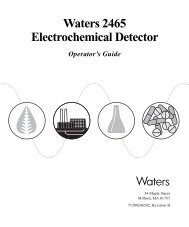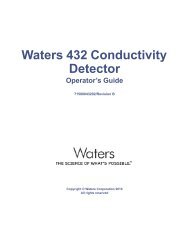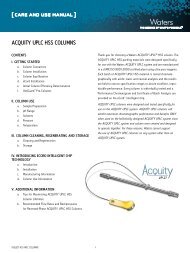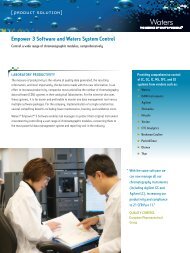ACQUITY UPLC HT Column Heater Instructions - Waters
ACQUITY UPLC HT Column Heater Instructions - Waters
ACQUITY UPLC HT Column Heater Instructions - Waters
- No tags were found...
Create successful ePaper yourself
Turn your PDF publications into a flip-book with our unique Google optimized e-Paper software.
<strong>ACQUITY</strong> <strong>UPLC</strong> <strong>HT</strong> <strong>Column</strong> <strong>Heater</strong> <strong>Instructions</strong>Note: This document is an addendum to Revision C of the <strong>ACQUITY</strong> <strong>UPLC</strong>System Operator’s Guide.Contents:TopicPageOverview 1Connecting the cable 4Installing the column stabilizer assembly 5Installing the column in-line filter 9Installing the column 10Installing the column in an MS system 13Maintenance 13Troubleshooting 19Specifications 20OverviewWhen installed on <strong>Waters</strong> ® <strong>ACQUITY</strong> <strong>UPLC</strong> ® Systems, the <strong>Waters</strong> <strong>ACQUITY</strong><strong>UPLC</strong> High Temperature (<strong>HT</strong>) <strong>Column</strong> <strong>Heater</strong> maintains one column at atemperature up to 90 ºC (194 ºF). The <strong>HT</strong> column heater is an assembly thatfits on top of the sample manager and contains the column stabilizerassembly, the optional column in-line filter unit, and a column.The <strong>HT</strong> column heater’s front compartment can accommodate any <strong>Waters</strong><strong>ACQUITY</strong> column up to 4.6 mm ID and 150 mm long. The column rests in aU-shaped tray, which swivels outward to any position between 0° and 180°and can receive the column from either side. Thus, in the 0°, “home”, position,the tray is directly above the sample manager and below the optical detector,and in the 180°, “away”, position, you can plumb the <strong>HT</strong> column heater into amass spectrometer (located on the system’s right).71500148606, Rev. A<strong>ACQUITY</strong> <strong>UPLC</strong> and <strong>Waters</strong> are registered trademarks, and eCord is a trademark of <strong>Waters</strong>Corporation. PEEK tubing is a registered trademark of Victrex Corporation. Phillips is aregistered trademark of Phillips Screw Co.All other trademarks are the sole property of their respective owners.Copyright © 2007 <strong>Waters</strong> Corporation.<strong>ACQUITY</strong> <strong>UPLC</strong> <strong>HT</strong> <strong>Column</strong> <strong>Heater</strong> <strong>Instructions</strong> 1
The <strong>HT</strong> column heater uses an element of insulated film to heat the columncompartment to any temperature between 5 ºC (9 ºF) above ambient and 90 ºC(194 ºF). A passive column stabilizer and thermal gasket inside the trayreduce sensitivity to ambient temperature swings and minimizebandspreading.A port on the <strong>HT</strong> column heater’s right-hand side receives the column’seCord chip. The eCord stores column information, which you can accessfrom the <strong>ACQUITY</strong> <strong>UPLC</strong> console.The <strong>HT</strong> column heater drip tray captures any leakage, routing it to thesample manager via a drip tube. If a leak sensor is fitted on the instrumentand it is activated, a message appears in the Status area of the <strong>ACQUITY</strong><strong>UPLC</strong> console, notifying you of the leak.At the rear of the <strong>HT</strong> column heater, a network switch offers seven Ethernetports to connect the <strong>ACQUITY</strong> <strong>UPLC</strong> instruments to the system.See also: <strong>ACQUITY</strong> <strong>UPLC</strong> Online Help and <strong>ACQUITY</strong> <strong>UPLC</strong> SystemOperator’s Guide (part number 71500082502).Requirements• Empower, Empower 2, or MassLynx 4.1 or later data application• <strong>ACQUITY</strong> <strong>UPLC</strong> Console• <strong>Waters</strong> ICOP v.1.23 or later for sample manager (ACQ-SM)• Sample manager or autosampler for v.1.3 or laterSafety considerationsObserve these warning and caution advisories when you perform installation,maintenance, or troubleshooting tasks.Warning: To avoid electric shock• power-off the sample manager before you connect or disconnect theexternal communication cable (between the sample manager andthe <strong>HT</strong> column heater). In addition, if the sample manager ispowered-on when you connect the cable, the sample manager willsustain damage.• do not open the <strong>HT</strong> column heater’s top cover. The <strong>HT</strong> columnheater does not contain user-serviceable components.2
Warning: To avoid electric shock• power-off and unplug the <strong>HT</strong> column heater before performing anymaintenance on the instrument or making any electricalconnections.• use power cord SVT-type in the United States and HAR-type orbetter in Europe. For other countries, contact your local <strong>Waters</strong>distributor.• connect the <strong>HT</strong> column heater to a common ground.Warning: To prevent burn injuries, set the column temperature to Off,and then allow the column compartment and its components to cool for60 minutes before touching them. Monitor the column compartmentinternal temperature to ensure all components are cool.Warning: To prevent injury and avoid possible exposure when workingwith hazardous solvents• install the system in a hooded environment.• ensure that the lab environment has a sufficient rate of airexchange.• using incompatible solvents can cause severe damage to theinstrument and/or injury to the operator.• to avoid possible exposure to hazardous solvents, do not remove thedrip tray.Warning: To prevent injury, always observe Good Laboratory Practiceswhen you handle solvents, change tubing, or operate the system.Review the Material Safety Data Sheets for the solvents in use so thatyou know their physical and chemical properties.Warning: Fire and explosion hazard. Do not use any solvents whoseauto-ignition temperatures are below 105 ºC (221 ºF).<strong>ACQUITY</strong> <strong>UPLC</strong> <strong>HT</strong> <strong>Column</strong> <strong>Heater</strong> <strong>Instructions</strong> 3
Caution:• To avoid damaging electrical parts, never disconnect an electricalassembly while power is applied to an instrument. To completelyinterrupt power to an instrument, set the power switch to Off, andthen unplug the instrument’s power cord from the AC outlet. Afterpower is removed, wait 10 seconds before you disconnect anassembly.• To prevent circuit damage because of static charges, do not touchintegrated circuit chips or other system components that do notrequire manual adjustment.• To avoid damaging the <strong>HT</strong> column heater, the weight of itemsstacked on top of it should not exceed 18.1 kg (40 pounds).Requirement: To obtain accurate, reproducible chromatograms, use onlyMS-grade solvents, water, and additives. For details, see Appendix D of the<strong>Waters</strong> <strong>ACQUITY</strong> <strong>UPLC</strong> System Operator’s Guide.Connecting the cableThe sample manager powers and communicates with the <strong>HT</strong> column heater.The external communication cable must be connected to the rear of the <strong>HT</strong>column heater and the sample manager.1. Make sure the sample manager and the <strong>HT</strong> column heater arepowered-off.2. Connect the external communication cable to the High Density (HD)port on the rear of the <strong>HT</strong> column heater.3. Connect the other end of the external communication cable to the QSPIport on the rear of the sample manager.4
Connecting the external cable:High DensityConnectorRear of <strong>HT</strong> column heaterETHERNETIIICH externalcommunicationcableRS-232(A)RS-232(B)QSPIETHERNETFuses andpowerconnectionRear of sample managerInstalling the column stabilizer assemblySee also: “Replacing the column stabilizer assembly” on page 18.Warning: To prevent burn injuries, set the column temperature to Off,and then allow the column compartment and its components to cool for60 minutes before touching them. Monitor the column compartmentinternal temperature to ensure all components are cool.Required materials• Phillips ® screwdriver• High-temperature outlet fitting wrench• 5/16” open-end wrench<strong>ACQUITY</strong> <strong>UPLC</strong> <strong>HT</strong> <strong>Column</strong> <strong>Heater</strong> <strong>Instructions</strong> 5
• <strong>Column</strong> stabilizer kit (part number 205000489 for 50- or 100-mmcolumn, or 205000494 for 150-mm column):– <strong>Column</strong> stabilizer assembly– Collet and compression screw multi-tool (collet separator)– 3 Phillips screws (1 is a spare)– 3 thermal gaskets (2 are spares)– PEEK ® tubing for connecting the column to the detector’s flow cellTo install the column stabilizer assembly:1. Open the <strong>HT</strong> column heater door, lift up and rotate the metal latchclockwise, and tilt the column heater tray 45 degrees downward.Opening the column heater tray:<strong>Column</strong> heater trayMetal latch2. Remove the clear, protective backing from the thermal gasket, and withthe thermal gasket oriented vertically, center it between the twothreaded holes.6
Applying the thermal gasket:Threaded holesThermal gasket3. Press the thermal gasket into the tray. Ensure that the gasket iscentered and formed into the bottom of the tray with equal lengths onboth sides.4. With the inlet tubing on the right, firmly press the column stabilizerassembly into the thermal gasket. Ensure that the thermal gasketuniformly envelops the sides of the column stabilizer and does not bunchbeneath it.<strong>Column</strong> stabilizer assembly (two styles):Reusable fittingsFor 50-mm or100-mm columnFor 150-mm columnTP02544Inlet tubing to injector<strong>ACQUITY</strong> <strong>UPLC</strong> <strong>HT</strong> <strong>Column</strong> <strong>Heater</strong> <strong>Instructions</strong> 7
Installing the column stabilizer assembly:Thermal gasket visiblealong both sides ofstabilizer<strong>Column</strong>stabilizerinlet tubingThreaded holes forPhillips screwsTP028455. Carefully route the column stabilizer inlet tubing through the groove onthe right-hand side of the tray.Caution: To avoid stripping the threads, do not overtighten screws.6. Insert two Phillips screws into the threaded holes, and tighten themgently using the Phillips screwdriver.7. Remove the O-ring retainer from the inlet end of the column stabilizertube, and then connect the inlet tube to injector port 6 of the samplemanager.8
Connecting to the injector:Inlet tubing ofcolumn stabilizerPort 6 of injectorInstalling the column in-line filterSee also: “Replacing the filter or the column in-line filter unit” on page 16.Caution: To prevent contamination, wear powder-free, non-latexgloves when connecting tubing and tightening fittings.To install the column in-line filter:1. Remove the O-ring retainer from the outlet end of the column stabilizertube.Tip: Before connecting, make sure that the ferrule is approximately3 mm from the end of the outlet tube and that the collet is touching theback of the ferrule.Positioning the fitting on the column stabilizer outlet tube:FerruleReusable fittingOutlet tube3 mmCollet<strong>ACQUITY</strong> <strong>UPLC</strong> <strong>HT</strong> <strong>Column</strong> <strong>Heater</strong> <strong>Instructions</strong> 9
2. Remove the column in-line filter unit from its packaging, and then pushthe outlet end of the column stabilizer tubing assembly into the in-linefilter inlet until it stops.Connecting the in-line filter unit:Flow<strong>Column</strong>In-line filter unit<strong>Column</strong> stabilizer tubingassemblyInletReusable fitting3. Holding the reusable fitting in place, rotate the in-line filter unit ontothe fitting until it is snug.4. Finger-tighten the fitting until it is snug, and then add a quarter-turn.Caution: To avoid damaging the tubing, use only your fingers totighten the tubing fittings.Installing the columnSee also: “Replacing the column” on page 15.To connect the column in-line filter unit and the column inlet:1. Remove the O-ring from the outlet end of the column in-line filter unit.2. Remove the plug from the column inlet.3. Push the outlet end of the column in-line filter unit into the column inletuntil it stops.Caution: To avoid damaging the tubing, use only your fingers totighten the fittings.4. Tighten the fitting until it is snug, and then add a quarter-turn.10
To install the PEEK tubing in the column outlet:1. Insert the PEEK tubing into the high-temperature outlet fitting until itstops.Caution: To avoid bandspreading, ensure that the tubing is fullybottomed in the fitting hole before tightening it.2. Holding the PEEK tubing, thread the high-temperature outlet fittinginto the column outlet (to the right) until it is finger-tight.3. Using a 5/16” wrench to hold the column steady, use thehigh-temperature outlet fitting wrench to give the outlet fitting aquarter turn.Caution: To avoid damaging the outlet fitting, do not over-tighten itwith the outlet fitting wrench.4. Push the PEEK tubing into the left-hand side of the column tray.To connect the PEEK tubing to the detector:1. Remove the protective cover from the PEEK tubing from the flow cellinlet in the detector.2. Attach the 0.0625-inch OD inlet tubing (included with the flow cell orthe stabilizer kit) to the column outlet. Check the label on the flow cellinlet tubing to ensure it matches the type of detector and flow cell inyour system.Connecting the column to a flow cell:OutletInletDetector flow cellassemblyDetector inlet tubing (PEEK) from columnTP02401<strong>ACQUITY</strong> <strong>UPLC</strong> <strong>HT</strong> <strong>Column</strong> <strong>Heater</strong> <strong>Instructions</strong> 11
3. Snap the column support clips onto the body of the column (one betweenthe reusable fitting and column). Rotate the clips so that the openingsface forward.4. Place the column in the tray.5. Close the column heater tray, and then push down the metal latch tosecure the column stabilizer tubing.6. Close the <strong>HT</strong> column heater door, and then inspect the seal around thefront panel to ensure it aligns correctly.Note: Proper alignment of the seal is critical for a stable thermalenvironment.7. Attach the eCord fob to the receptacle on the right-hand side of the <strong>HT</strong>column heater.Connecting the eCord:eCord receptacleeCord fobWarning: To avoid electric shock or possible damage to thecomponents, power-off the sample manager before you connect ordisconnect the external communication cable (between the samplemanager and the <strong>HT</strong> column heater).Requirement: The external communication cable must be connected tothe HD port on the rear of the <strong>HT</strong> column heater and the QSPI port onthe rear of the sample manager, so that the sample manager can powerand communicate with the <strong>HT</strong> column heater.8. Power-on the sample manager and the remaining <strong>ACQUITY</strong> <strong>UPLC</strong>instruments.12
Setting the column temperatureTo set the temperature:1. In the Empower Run Samples window, click Instrument method editor >View Method tab.Alternative: MassLynx main window > Instrument tab > Inlet Method.2. Click ACQ-SM (Empower) or Autosampler (MassLynx).3. Specify a value between “ambient plus 5 °C” and 90 °C.Alternative: Select Off to keep the column at ambient temperature.Tip: The <strong>HT</strong> column heater does not have cooling capabilities. Thelowest temperature is 5 degrees above ambient temperature.4. Click OK (for MassLynx only).5. Allow the column to warm. In the Plots area of the <strong>ACQUITY</strong> <strong>UPLC</strong>Console, monitor temperatures to ensure that the system is thermallyequilibrated.Installing the column in an MS systemIf your system includes a mass spectrometer positioned to the right of thesystem stack, open the <strong>HT</strong> column heater door in the “away” position(swinging rightward) to connect to the MS inlet without increasing the tubinglength. The MS drip tray is required to ensure any solvent leaked from thecolumn or column connections is routed into the drip management system.See also: chapter 2 of the <strong>Waters</strong> <strong>ACQUITY</strong> <strong>UPLC</strong> System Operator’s Guideto replace or install the column, in-line filter, and column stabilizer assemblyin a <strong>HT</strong> column heater for MS detection.Maintenance<strong>Waters</strong> recommends that you perform routine maintenance to ensure reliableoperation and accurate results. When using the system throughout the day(and on nights and weekends), or when using aggressive solvents such asbuffers, perform maintenance tasks more frequently.<strong>ACQUITY</strong> <strong>UPLC</strong> <strong>HT</strong> <strong>Column</strong> <strong>Heater</strong> <strong>Instructions</strong> 13
Recommended maintenance schedule:Maintenance procedure Frequency For information...Replacing the filter in thecolumn in-line filter unitReplacing the column in-linefilter unitSpare partsDuring scheduledpreventivemaintenanceAfter you use the sixfilters that accompanythe filter unitYou can replace the column, the column stabilizer assembly, the columnin-line filter unit, and the filter.See also: www.waters.com for information on columns.See page 16.See page 9.Replacing the column As needed See page 5.stabilizer assemblyReplacing the column As needed See page 15.Caution: <strong>Waters</strong> does not recommend you replace parts that are notlisted as spare parts.Recommended spare parts:ItemPart Number<strong>Column</strong> stabilizer assembly 205000489<strong>Column</strong> stabilizer assembly, 150-mm column 205000494<strong>Column</strong> in-line filter unit 205000343Replacement filters 70000277514
Maintaining the <strong>HT</strong> column heaterWarning: To avoid electric shock or possible damage to thecomponents, power-off the sample manager before you connect ordisconnect the external communication cable (between the samplemanager and the <strong>HT</strong> column heater).Warning: To avoid possible exposure to hazardous solvents, do notremove the tray.Under normal operating conditions, the <strong>HT</strong> column heater does not requireroutine maintenance. If residue from solvent leaks accumulates in the tray,remove the column, and wipe the tray clean with a soft cloth.Replacing the columnRequirement: Stop any currently running mobile phase before replacing thecolumn.Warning: To prevent burn injuries, set the column temperature to Off,and then allow the column compartment and its components to cool for60 minutes before touching them. Monitor the column compartment’sinternal temperature to ensure all components are cool.Caution: To prevent contamination, wear powder-free, non-latexgloves when replacing the column.To remove the column:1. After cooling, open the <strong>HT</strong> column heater door.2. Disconnect the stabilizer outlet tube from the column or in-line filter.3. Place the forked end of the collet separator over the collet on the columnstabilizer tube, and gently wiggle it back and forth to pry the reusablefitting loose from the collet.<strong>ACQUITY</strong> <strong>UPLC</strong> <strong>HT</strong> <strong>Column</strong> <strong>Heater</strong> <strong>Instructions</strong> 15
Disassembling the reusable fitting:FerruleReusable fittingTubing frominjectorColletCollet separator4. Replace the ferrule.5. Continue with “Installing the column” on page 10.Replacing the filter or the column in-line filter unitRecommendations:• To minimize wear on the compression fittings, replace the in-line filterunit only after you use the six filters that accompany the unit.• The column in-line filter unit cannot completely prevent or reversesystem contamination. You should therefore try to preventcontamination and troubleshoot it when it occurs, as well as clean orreplace contaminated components.Caution: To prevent contamination, wear powder-free, non-latexgloves when replacing the filter.See also: “Controlling Contamination in Ultra Performance LC ® /MS andHPLC/MS Systems” (part number 715001307).Requirement: Stop any currently running mobile phase before replacing thefilter.Warning: To prevent burn injuries, set the column temperature to Off,and then allow the column compartment and its components to cool for60 minutes before touching them. Monitor the column compartmentinternal temperature to ensure all components are cool.16
Required materials• Open-end wrenches, 5/16-inch (2)• Powder-free, non-latex gloves• Replacement filter or column in-line filter unitTo replace the filter or the column in-line filter unit:1. Open the column heater door, lift up the metal latch, and tilt the columnheater tray downward.Opening the column heater tray:<strong>Column</strong> heater trayMetal latch2. Pull out the column and in-line filter unit from the tray so that you canaccess the in-line filter unit.3. Disconnect the column stabilizer tubing assembly from the in-line filterunit.4. To replace the in-line filter unit, detach it from the column inlet, attacha new unit in its place, and continue with step 8.5. To replace the filter, open the in-line filter unit by placing two 5/16-inchopen-end wrenches onto the flats. Do not detach the unit from thecolumn inlet.<strong>ACQUITY</strong> <strong>UPLC</strong> <strong>HT</strong> <strong>Column</strong> <strong>Heater</strong> <strong>Instructions</strong> 17
Disassembling and assembling the in-line filter unit:FlowOutlet assembly Filter Inlet nutTP025436. From the in-line filter unit, remove the inlet nut that contains the usedfilter.Note: Discard the used filter; it cannot be used again.7. Insert a new filter, and then reassemble the in-line filter unit.8. Start the mobile phase flowing.9. Examine the components for leaks, tightening fittings as needed.10. Place the assembled components into the column tray, push down themetal latch to secure the tubing, and tilt the tray upward to the closedposition.Replacing the column stabilizer assemblyPlace wrenches on flats toassemble and disassemble.Requirement: Stop any currently running mobile phase before replacing thecolumn stabilizer assembly.Warning: To prevent burn injuries, set the column temperature to Off,and then allow the column compartment and its components to cool for60 minutes before touching them. Monitor the column compartmentinternal temperature to ensure all components are cool.Caution: To prevent contamination, wear powder-free, non-latexgloves when replacing the column stabilizer assembly.18
To replace the column stabilizer assembly:1. Disconnect the inlet tube from injector port 6 of the sample manager.2. Open the door.3. Using the Phillips screwdriver, loosen the two screws that fasten thecolumn stabilizer assembly to the tray.4. Remove the column stabilizer assembly from the thermal gasket.5. Using the 1/4-inch and 5/16-inch open-end wrenches, disconnect thecompression fitting that attaches the column stabilizer assembly to theoptional in-line filter or to the column.6. Continue with “Installing the column stabilizer assembly” on page 5.TroubleshootingWarning: To avoid electric shock or possible damage to thecomponents, power-off the sample manager before you connect ordisconnect the external communication cable between the samplemanager and the <strong>HT</strong> column heater.SymptomAn error message about the <strong>HT</strong>column heater appears.The <strong>HT</strong> column heater or samplemanager loses power or fails topower-on, or status LEDs are unlit.You must monitor column history,determine column status, or clean,regenerate, or equilibrate a column.SolutionSee <strong>ACQUITY</strong> <strong>UPLC</strong> online help.Replace the fuse in the samplemanager. The sample managerpowers the <strong>HT</strong> column heater.See chapter 7 in the <strong>ACQUITY</strong> <strong>UPLC</strong>System Operator’s Guide and<strong>ACQUITY</strong> <strong>UPLC</strong> online help.<strong>ACQUITY</strong> <strong>UPLC</strong> <strong>HT</strong> <strong>Column</strong> <strong>Heater</strong> <strong>Instructions</strong> 19
SymptomYou must install reusable fittings.You suspect contamination.SolutionSee “Installing Finger-tight ReusableFittings (<strong>Column</strong> <strong>Heater</strong>)”, availablein the <strong>Waters</strong> Support Center(www.waters.com).See “Controlling Contamination inUltra Performance LC ® /MS andHPLC/MS Systems” (part number715001307).SpecificationsEnvironmental specifications:AttributeSpecificationOperating temperatureOperating humidityShipping and storage temperatureShipping and storage humidityAcoustic noise (instrumentgenerated)Temperature control4 to 40 °C (39.2 to 104 °F)


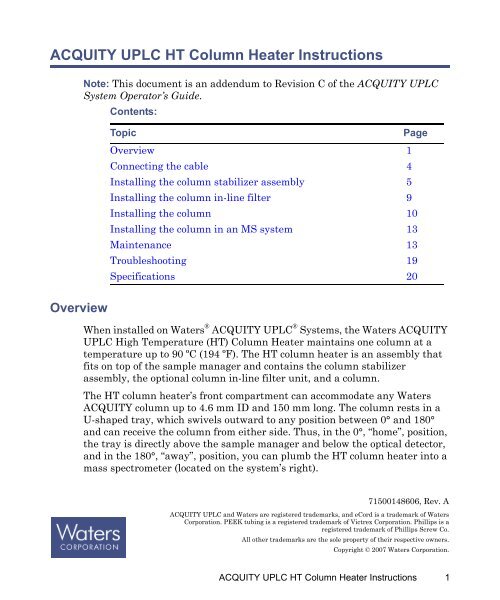
![[ TIPS ] [ ACQUITY UPLC SYSTem QUICk START CARD ] - Waters](https://img.yumpu.com/51427825/1/190x245/-tips-acquity-uplc-system-quick-start-card-waters.jpg?quality=85)
